I want what she’s having!
Same Job, Same Pay Requirement
The classic line from the movie When Harry Met Sally sums up human behaviour. We always want what others around us have.
Having sat through countless Enterprise Agreement negotiations, I have faced regular claims from unions to include a ‘labour hire clause’ in the Agreement. The long-held view of most employers has been to push back on that notion, with the business lens of having the flexibility to bring in labour hire to subsidise an employee workforce when required, and for the commercial arrangement around pay rates for labour hire employees being something that was not part of discussions. This has all changed.
The Fair Work Legislation Amendment (Closing Loopholes) Act 2023 has brought about significant changes to the Australian employment landscape, particularly the amendment associated with same job, same pay requirements for both employers and labour hire organisations. This amendment aims to ensure that labour hire employees are remunerated at the same rate that the employees of the host employer are paid if they are performing the same role.
Under the new legislation, employers and labour hire organisations are now required to pay employees equally for performing the same job. This means that workers hired through a labour hire organisation must receive the same wages, entitlements, and working conditions as their counterparts who are directly employed by the host company.
Lessons for Employers
Calculate the rates
As this piece of legislation has played out, it has proven difficult to calculate and compare the rates of pay between labour hire and host employer employees. In a recent matter (“Automotive, Food, Metals, Engineering, Printing and Kindred Industries Union” known as the Australian Manufacturing Workers’ Union (AMWU) (188V) v Paper Australia Pty Ltd T/A Opal – [2023] FWC 2129 | Fair Work Commission) the union claimed that the wages and conditions paid to labour hire employees was not equal to those paid to employees of the host employer. In this instance the employer was able to successfully argue that all entitlements (allowances, bonus and higher overtime rates) resulted in the labour hire employees being paid at least what the host employer’s employees are paid. Regardless of the outcome of this matter, it demonstrates that calculating the wages and conditions is not simple.

Compliance is key
It is essential for employers, both labour hire and host employers, to review their current employment practices and contracts to ensure they are in line with the new legislation. Both labour hire and host employers have responsibility to ensure that payment terms are understood and are applied equally. Failure to comply with the same job, same pay requirements could result in costly penalties and legal action.
Transparency is crucial
Employers should be transparent about the wages, entitlements, and working conditions offered to both host employees and labour hire employees. Clear communication and fairness in remuneration are vital to maintaining trust and morale among workers but is also vital for employers to meet their requirements under this amendment.
Proactive approach
Employers should proactively engage with labour hire organisations to ensure that both parties are aware of their responsibilities under the new legislation. Regular monitoring and review of employment practices can help prevent any potential breaches and ensure compliance.
Closing Loopholes
The Fair Work Legislation Amendment (Closing Loopholes) Act 2023 could potentially see an end to the union claim for ‘labour hire clauses’ in Enterprise Agreements, but the requirement to ensure same job, same pay is happening sits firmly with employers.
Setting it as part of legislations, means that Employers must take proactive steps to ensure compliance, with the risk of civil penalties against both host employers and labour hire employers for such things as breaches to ‘anti-avoidance’ provisions.
Connect with us
If you would like more information or want to learn more, please contact us here and a Mapien Workplace Strategist will be in touch ASAP.
The Fair Work Commission’s Expert Panel has awarded a 3.75% increase to the National Minimum Wage and the minimum wages in Modern Awards.
Accordingly, the National Minimum Wage will be increased to $915.90 per week or $24.10 per hour and all Modern Award minimum weekly wages will be increased by 3.75% from the first full pay period commencing on or after 1 July 2024.
Application of the Increase to the National Minimum Wage and Modern Awards
The increase applies to minimum wages for all employees, including junior employees, trainees, apprentices, supported wages and piece rates. Weekly wages will be rounded to the nearest 10 cents.
If an Enterprise Agreement applies to an employee and the employee would otherwise be covered by a Modern Award, then the employee’s base rate of pay under the Enterprise Agreement must not be less than the base rate of pay that would be payable to the employee under the Modern Award.
If an Enterprise Agreement applies to an employee and the employee is not covered by a Modern Award, then the employee’s base rate of pay under the Enterprise Agreement must not be less than the National Minimum Wage.
If no Enterprise Agreement or Modern Award applies to an employee, then the employee cannot be paid less than the National Minimum Wage.
What factors did the Panel consider?
The Panel advised that key factors from current economic circumstances presented clear guidance for this year’s Decision. These factors include living standards, the needs of low paid Australians, workforce participation and striving for gender equality. The Panel further noted that lower inflation, no real change to labour productivity and a relatively strong labour market and profit growth in a majority of sectors, were also key considerations in reaching this year’s Decision.
The Panel also highlighted their consideration of upcoming cost of living relief which will directly assist those employees who are reliant on Modern Award wages. These measures include upcoming tax cuts, increase to minimum superannuation contributions from 11% to 11.5% and other proposed measures, such as the Energy Bill Relief Fund.
The Panel confirmed that this year’s Decision is broadly aligned with forecasted wage increases across the general market and expected lower inflation in 2025.
The Panel indicated that approximately 20.7% of employees in Australia are paid in accordance with Modern Award wages, with four key sectors heavily reliant on these wages. The four key industry sectors which contain the largest proportions of modern award reliant employees are Accommodation and food services, Health care and social assistance, Retail trade and Administrative and support services. The Panel reiterated, as they have done in previous years, that typically these employees work part-time or casual hours and are predominantly female.
In accordance with their commitment to addressing gender equity in the Australian workforce, the Fair Work Commission announced the successful completion of their research into gender undervaluation which has brought to light various priority areas. Specific employees highlighted in these priority areas included early childcare workers, disability home care and other social care employees, and medical support professions, such as dental assistants, psychologists and pharmacists. The Panel confirmed that by next year’s Annual Wage Review Decision, they will have undertaken proceedings to address gender undervaluation and will provide further guidance at that time.
Interested to learn more?
If you would like more information on the impact that the minimum wage increase might have to your organisation, please contact us here and a Mapien Workplace Strategist will be in touch ASAP.
Increase to the Temporary Skilled Migration Income Threshold (TSMIT)
From 1st July 2024, the TSMIT will increase from $70,000 to $73,150.
New nomination applications (Subclass 482 and Subclass 186) lodged from the 1st July 2024 will need to meet the new TSMIT of $73,150 or the annual market salary rate, whichever is higher.
This change will not affect existing visa holders and nominations lodged before the 1st July 2024.
Budget update – the main changes
Following a massive net overseas migration intake of 528,000 in 2022/2023, it is predicted that net overseas migration will drop to 395,000 in 2023/2024 and further in 2024/2025 to 260,000.
The migration planning levels are assessed on a yearly basis, from 2025/2026 these planning levels will be set for a four year period, allowing transparency for better long term forecasting.
- Permanent Migration program will be capped at 185,000 places for the 2024/2025 year, with 132,000 places allocated to the skilled stream, and 52,500 allocated to the family stream, the bulk of which will be available for the partner visa stream (40,500)
- $18.3m investment over four years for further reform to drive economic prosperity and restore the integrity of Australia’s visa program.
Visa Changes
It was announced that the following visa changes will be happening in the new financial year.
- A new national innovation visa to replace the current Global Talent Visa.
- TSS Visa Changes – a reduction to the work experience requirement for the TSS subclass 482 visa from two years of experience to one year. This will take effect towards the end of November 2024.
- A new professional visa for Indian Nationals paving a pathway for 3,000 graduates with specific knowledge and skills, allowing them to work in Australia for up to two years.
- A new ballot process for the Work and Holiday Visa program for China, Vietnam and India, for FY25.

The Migration Strategy
The Governments vision is to get migration working for the nation, helping deliver a prosperous and secure Australia.
The first comprehensive review of the migration system in May 2023 found that the system was broken, and that there was a lack of clarity on what Australia was trying to achieve through migration. The Government is focusing on having a better planned migration system that works for the nation, aiming to strengthen the community and improve the standard of living.
The Governments five core objectives under this review are:
- Better living standards for all – Meeting skills shortages: Migration is not a substitute to replace Australian employees or not to train Australians permanent residents or citizens.
- A Fair Go for all – Pro Wages: Build secure jobs for all with better working conditions preventing migrant worker exploitation
- Building a stronger Australian Community: Moving away from temporary residency (TR) to permanent residency so those TR visa holders are not continually living in limbo
- Strengthening International relationships: Building stronger economic and social connections with international partners (APAC)
- Making the system work: Make if fast and efficient
These objectives will ultimately lead to a new and better working migration program, replacing the Subclass 482 with the Skills in Demand Visa later in the year.
Consultation on draft new core skills occupation list (CSOL)
The Jobs and Skills Australia (JSA) are responsible for undertaking labour market analysis and stakeholder engagement to assist the Government with final decisions on the new CSOL, ensuring that our temporary skilled migration program is targeted towards Australia’s workforce needs.
Occupations on the final list will reflect occupations as defined in the most recently updated Australian and New Zealand Standard Classification of Occupations (ANZSCO). The CSOL will determine which occupations are available for sponsorship under the proposed new Skills in Demand Visa. This new visa will have three tiers and most applications are expected to fall within the mid-tier Core Skills Stream (Tier 2). This tier will be for occupations with minimum earnings that fall between $70,000 to $135,000, which will be the minimum salary threshold for the Specialist Skills Stream (Tier 1).
The JSA has developed a Migration Labour Market Indicator Model which will be used in conjunction with stakeholder engagement, to provide advice to the Government. The new model and eventual CSOL will build on the Skills Priority List, and the initial consultation process which is now underway.
Mapien is finalising its submission to the JSA with a view to helping ensure the occupations which are critical to our clients remain on the new employer sponsored visa lists.
Takeaway
This is going to be a year of change with the Government undertaking thorough research on the labour market as it starts to form the policy settings for the new Skills in Demand Visa.
If you need advice on around sponsorship or your current visa cohort, please as always, reach out to us at Mapien.

This is blog #9 in our series on coaching models. Sign up to our mailing list to make sure you don’t miss out on our future content.
Did you know that as a leader, you likely spend anywhere from 70-90% of the work day communicating? If that figure seems like a lot, consider how much time you spend each day in meetings, emails, phone calls, and presentations. It quickly adds up!
One of the most powerful skills you can develop is your ability to communicate effectively — and not only because it occupies the bulk of your time. Good communication is essential for sharing your ideas and your vision, for building trust, and navigating change. On the other hand, poor communication can lead to project delays, failure, low morale, poor performance, and lost sales.
But what many people don’t realise is that good communication is so much more than delivering a clear message. You also need to get the channel right.
Why Choosing the Right Channel Matters
In a study that tracked how CEOs spend their time, they reported that 61% of communication was face-to-face, followed by 24% electronic (like email) and 15% by phone or physical mail.
But as a leader, how do you know what method of workplace communication is most appropriate for the message you need to deliver?
Choosing the right internal communication channel is easier said than done, with so many options available within a modern organisation, such as:
- One-on-one meetings
- Team meetings
- Video calls
- Phone calls
- Emails
- Intranet platforms
- Social media posts
- Messenger applications
Each of these channels has different strengths, weaknesses, and use cases. Choosing the right one is crucial to ensuring your message or communication campaign can achieve the desired outcomes.
8 Considerations for Choosing Your Communication Channels
In order to choose the right methods of communication, you need to match the content and intent of your message with the characteristics of the platform. So, we’ve come up with eight prompts to help you consider your message and your corporate communication channels.
1. How Urgent is the Message?
If you need your message to be seen or acted upon urgently, you’ll need to choose a channel to support that. For instance:
- If all relevant parties working in the same area, urgent messages may be delivered face-to-face
- If all relevant parties are not in the vicinity, it’s standard practice to use phone calls for urgent matters
Note that the opposite rule also applies. If your message is non-urgent, a phone call or unscheduled face-to-face meeting may be seen as disruptive or distracting.
2. Is One-Way or Two-Way Communication Appropriate?
Consider whether your message requires a response or further discussion when choosing your channels. Some communication channels are designed for one-way communication such as announcements or notifications. Other channels are designed to facilitate two-way communication, with features that encourage comments, feedback, and conversation.
Note that in most cases, it’s best to facilitate two-way communication because this shows that you’re open to ideas and listening to your stakeholders. Also, if you choose a channel that doesn’t allow for two-way communication, your stakeholders may still respond, but will choose whatever channel they prefer to reach you on, which can be harder to control or manage.
3. Is Your Goal to Influence People?
Sometimes you’ll need to deliver a message with the goal of influencing an outcome or encouraging buy-in. Generally speaking, if you’re trying to generate more influence and stronger commitments, you’ll have more success if you can deliver the message via face-to-face channels. Plus, face-to-face communication helps to build stronger relationships, ensures you don’t miss important feedback (such as non-verbal cues and social dynamics), and can help you build a more collaborative, engaging environment.
4. How Formal is the Communication?
It’s a good idea to match the level of formality of your message to the level of formality of the channel. You wouldn’t schedule a meeting ahead of time just to talk about what you did on the weekend — and you wouldn’t start a conversation about someone’s end-of-probation performance in the hallway.
You can use this strategically, too — the medium is the message. If you want someone to take you seriously, choose a more serious channel. If you want someone to perceive your message in a more casual way, deliver it in a casual manner.
5. Is the Message Sensitive or Confidential?
Some messages will be of a more sensitive nature or require confidentiality for legal reasons. As such, you’ll need to select a channel where you can control who sees or hears the message.
You should also keep in mind other potential audiences for your message. An obvious example is that a LinkedIn post aimed at internal audiences may also be seen by customers, competitors, future employees, and members of the public. But an internal email, message, or intranet post also has the potential to reach unintended audiences via forwarding or screenshots. For the most sensitive or confidential topics, a private face-to-face meeting is probably the safest option.
6. Will People Need to Refer Back?
Would it be useful for your message to be available for future reference? For example, does it contain useful information that’s relevant to a broader project, piece of work, or audience?
Messages, emails, and discussions are easily lost and forgotten. Instead, you may decide to publish the information as a video or written post in your company-wide intranet so that it’s easy to find and reference in future.
7. What is Your Workplace Communication Culture?
Another consideration is the broader communication culture within your workplace. For instance, are certain methods of communication more prioritised and valued over others? If so, these may be important channels through which to continue your communication, regardless of the message you deliver, any potential discomfort, or any logistical inconvenience.
A further cultural aspect is whether your organisation expects communication to occur at the same time (synchronous) or at different times (asynchronous) for different people. Based on this expectation, certain channels will be more suitable than others.
8. What Does Your Audience Prefer?
Each of the above considerations should be tempered with this final consideration: who are you trying to reach and what do they prefer or expect?
It’s always a good idea to ask your audience about their preferences, either directly or via a survey. And take note of how people respond to your communication via different channels — you’ll soon discover what works best for different audiences.
How to Select Your Channel
We’ve developed a simple model to help you work through the above considerations and hone in on the best channel for your message.
Step 1: Assess Your Channels
The first step to select a communication channel is to reflect on your options. What are the internal communication platforms and methods used in your workplace? And what are their characteristics?
You may like to use or recreate the above matrix template, placing a ✔ or ✖ in each square, based on the characteristics of each channel. This will allow you to see (at a glance) which channels are best suited to different messages and scenarios.
Step 2: What’s Your Message and Intent?
Now reflect on the message and intent of that message. Is it urgent? How formal is it? Does it need to influence people? Do you want to invite feedback or conversation? Will it be referred to in future? And are its contents sensitive or confidential?
Use the matrix from step 2 to determine which communication channels are most appropriate for your message, while keeping in mind your audience preferences and workplace culture.
Step 3: Reflection
After you’ve communicated your message, take some time to reflect on how it went. Was the message or campaign received as intended? What kind of feedback did you get? What would you do differently next time?
If the message wasn’t received as intended, you may need to update your matrix to more accurately reflect your workplace context so that you can choose a more appropriate channel in future.
Get Leadership and Coaching Support
One of the most powerful things you can do is to develop your skills and understanding in communication — especially since so much of your role as a leader is wrapped up in communicating with others.
By working through these considerations and steps identified above, you’ll be all set to confidently choose the right platform for each message.
We’ll be back soon with our final coaching model as we wrap up this series. In the meantime, you can reach out to our team for help with building leadership skills, leadership coaching, and more tools like this one.
Given that a hiring error can cost up to 21% of the mis-hire’s annual salary, the push towards accurate and dependable recruitment methods has never been more pertinent. The economic impact of bad hires has generated a shift towards psychometric testing marking a move towards more data-driven and analytical recruitment strategies. This approach aims to improve the efficiency and fairness of hiring processes, while also providing a more accurate prediction of a candidate’s future performance. As job roles become increasingly complex, and the need for adaptable and culturally aligned talent is more pronounced, psychometric testing offers valuable insights that go beyond traditional resumes and interviews, helping businesses reveal the true potential of their applicants.
Psychometric testing has become a key tool in modern recruitment, helping organisations match the right candidates with the right job roles more effectively. By assessing a candidate’s cognitive abilities, personality traits, and situational judgement, this approach provides a comprehensive view that goes beyond the traditional resume and interview process. It enables hiring managers to make decisions that are not only informed but also deeply aligned with the organisation’s culture and values.
What is psychometric testing?
Psychometric testing, put simply, is a scientific method used to measure individuals’ mental capabilities and behavioural style, offering a scientific approach to assess how well someone might fit a job role.
It evaluates intelligence, personality traits, and work preferences, giving a deeper insight into a candidate’s potential beyond what can be learned from resumes and interviews. The process is standardised, usually online, and includes a professional analysis of results. It’s a tool that adds depth to the hiring process, providing both employers and candidates with valuable insights.
Why are psychometric tests important in the hiring and recruitment process?
Finding the right candidate goes beyond just skill matching; it’s about ensuring a good fit with the company’s culture and values. Psychometric testing plays a key role in this process by providing objective, in-depth data on an individual’s compatibility with a role. This approach extends past the subjective judgments of interviews and the basic information from CVs, offering a more thorough understanding of a candidate’s capabilities and personality.
The strength of psychometric tests lies in its comprehensive and objective assessment. Evaluating crucial job-related skills and the less tangible, yet important, aspects of how a candidate might mesh with the team and the broader company culture. This helps to avoid costly hiring mistakes by offering insights into areas often overlooked by traditional hiring methods. Promoting fairness and equality by evaluating every candidate against the same standards, supporting inclusive hiring practices.

Psychometric testing differentiates itself by not just considering a candidate’s present qualifications but also by forecasting their potential to grow and succeed within the organisation. It’s about enhancing the recruitment process to make it more effective, ensuring new hires contribute positively to the team and company at large.
Enhanced Predictive Accuracy
Psychometric tests are scientifically designed to predict a candidate’s job performance by measuring their cognitive abilities and behavioural traits. This predictive power helps employers make more informed decisions, foreseeing how well a candidate will adapt to the role and contribute to achieving organisational goals.
Cultural Fit Assessment
A successful hire isn’t just about skills; it’s also about finding someone who aligns with the company’s culture. Psychometric testing provides an objective assessment of this fit, ensuring they’re likely to gel with the team and environment, which is key to long-term success.
Objective Evaluation
As many employers work towards eliminating bias and promoting diversity, psychometric tests offer an impartial method to assess candidates. By providing all applicants with the same set of questions and evaluating them based on standardised criteria, these tests help level the playing field and reduce unconscious bias in the selection process.
Streamlined Recruitment Process
Incorporating psychometric assessments can streamline the recruitment process, identifying the most suitable candidates early on. This efficiency reduces the time and resources spent on interviewing unsuitable candidates and can significantly lower the costs associated with turnover and rehiring.
Development and Retention
Psychometric tests not only aid in the hiring process but also in the development and retention of employees. Understanding an individual’s strengths and areas for improvement can guide personalised development plans, enhancing job satisfaction and employee retention rates.
Psychometric testing enriches the recruitment and selection process by providing a comprehensive, unbiased view of a candidate’s potential. These assessments bridge the gap between a candidate’s present qualifications and their future performance and fit within the company, making them an invaluable tool in the modern hiring landscape.
What are the benefits of psychometric testing?
The benefits of psychometric testing extend well beyond the initial selection and hiring phases, offering long-term advantages for both employers and candidates. By utilising these assessments, organisations can not only refine their recruitment strategies but also enhance their overall workplace environment.

For Employers
Improved Hiring Quality
Psychometric testing contributes to a higher quality of hire by ensuring that candidates’ abilities and personality traits align with the job requirements and company culture. A study published in the Journal of Intelligence found that cognitive ability tests are strong predictors of job performance across the vast majority of occupations, significantly improving hiring outcomes.
Cost Efficiency
The cost of a bad hire can be substantial, including wasted salary, training expenses, and decreased team productivity. Psychometric testing helps mitigate these risks by providing an additional layer of screening. According to the Society for Human Resource Management (SHRM), the average hard costs for hiring is $4,700, but with employers estimating the true figure to actually be up to three to four times the position’s annual salary for replacing a bad hire. By reducing turnover through more informed hiring decisions, companies can save significant resources in the long run.
Enhanced Team Dynamics
By assessing personality traits and work preferences, psychometric tests can aid in assembling high-performance teams that are more cohesive and effective. This alignment can improve team dynamics, foster a positive work environment, and increase overall productivity.
Data-Driven Decisions
These tests transform hiring from a subjective art into a more objective science, allowing employers to make decisions based on quantifiable data. This shift not only bolsters the fairness of the recruitment process but also supports diversity and inclusion by minimising unconscious biases.
For Candidates
Fair Assessment
Candidates benefit from a level playing field where they are assessed based on their actual abilities and potential, rather than on resume credentials or the ability to perform in an interview alone. This fairness can increase the attractiveness of an employer to prospective job seekers.
Personal Insight
Even if not selected for a role, candidates can gain valuable insights into their strengths and areas for improvement through psychometric testing feedback. This feedback can be instrumental in personal development and future job searches.
Better Job Fit
For candidates, being selected through a process that includes psychometric testing often leads to better job satisfaction. This is because the role is more likely to align with their skills, personality, and work preferences, reducing the likelihood of early departure.
Types of psychometric tests
Psychometric assessments and testing can be broadly categorised into three main types: personality tests, ability tests, and behavioural/skill based assessments (including situational judgement tests). Each type plays an important role in evaluating different elements of a candidate’s profile, offering comprehensive insights into their potential suitability for a role.
Personality Tests
Personality tests delve into the nuances of an individual’s character, behaviour, and preferred work style, assessing traits like extraversion, agreeableness, openness, conscientiousness, and emotional stability. The Myers-Briggs Type Indicator (MBTI), for instance, categorises people into 16 distinct personality types, reflecting different ways individuals perceive the world and make decisions, and along with other ‘type’ based assessment provides incredible insight for existing teams to be able to maximise their effectiveness as a team. Similarly, the Big Five Personality Traits model evaluates individuals across five major dimensions of personality with a stronger and more scientifically accurate ‘trait’ based approach to assessing personality, proving invaluable for employers looking to gauge a candidate’s potential fit within a team, their adaptability to the company’s culture, and their approach to facing workplace challenges. This makes personality assessments particularly crucial for roles necessitating significant interpersonal interaction or a specific type of personality alignment.
Ability Tests
Also known as aptitude tests, ability assessments measure a candidate’s cognitive capabilities, shedding light on their potential to undertake tasks and navigate problem-solving scenarios effectively. These tests range from general assessments to more specific ones targeting verbal reasoning, numerical ability, logical reasoning, and spatial awareness. For example, Raven’s Progressive Matrices test logical reasoning while the Numerical Reasoning Test gauges numerical ability. Through these assessments, employers can identify candidates with the analytical prowess, quick learning skills, and the ability to manage complex information, making such tests indispensable for positions that require robust analytical and problem-solving skills.
Behavioural/Skill Based Assessments
This type of assessment, which includes the broad category of Situational Judgement Tests (SJTs), can take the approach of placing candidates in hypothetical, job-related scenarios, asking them to choose or rank the most effective responses. Commonly in testing for recruitment and selection this includes Emotional Intelligence tests, Situational Safety Awareness tests, sales skills, interpersonal skills, and more. When tailored to specific job roles, these tests assess judgement, decision-making abilities, and how well a candidate’s skills and knowledge translate into practical, on-the-job situations. Whether it involves managing a challenging customer service issue or resolving conflict within a team, skill based tests and SJTs provide a lens into how candidates apply their judgement and decision-making skills in real-world contexts. This aspect of psychometric testing is especially relevant for roles that prioritise leadership, decision-making, and interpersonal skills, offering a window into how a candidate might perform in critical, everyday work scenarios.

The Debate Around Psychometric Testing in Recruitment
The use of psychometric testing in recruitment often sparks debate, especially concerning its impact on diversity, equity, and inclusion (DE&I). Research suggests that these tests can inadvertently disadvantage candidates across racial or minority groups and those with disabilities or mental health conditions, potentially undermining efforts to foster a diverse and inclusive workforce. The concern lies in the fact that standard tests may not accurately reflect the abilities of individuals with certain disabilities or mental health issues, thereby skewing results and limiting opportunities for these candidates.
Acknowledging these complexities does not diminish the value of psychometric evaluations in creating inclusive hiring frameworks. Rather, it highlights the necessity for a thoughtful approach in their application. With careful planning and consideration, psychometric assessments can be adapted to accommodate a wide range of candidates, ensuring fairness and accessibility. For instance, adjustments can be made to the testing environment or to the tests themselves, such as allowing extra time for individuals with specific needs or providing alternative formats for those with sensory impairments.
By integrating psychometric testing with a broader suite of assessment methods you can further mitigate potential biases. This holistic approach to candidate evaluation ensures that decisions are not solely based on test results but are informed by a comprehensive understanding of each individual’s skills and potential.
Preparing for a Psychometric Test
Facing a psychometric test can seem daunting, but with the right preparation, candidates can approach these assessments with confidence. Here are some general tips and strategies to help navigate the process:
- Familiarise Yourself: Understand the types of questions and formats you might encounter. Many test publishers provide practice tests or sample questions.
- Practice Regularly: Engaging with practice materials can improve your speed and accuracy under test conditions.
- Review Basic Skills: Depending on the test, brushing up on basic maths, reading comprehension, or logical reasoning skills can be beneficial.
- Rest and Relaxation: Ensure you’re well-rested and mentally prepared on the day of the test. A clear mind performs better.
- Mindset and Attitude: Approach the test with a positive attitude. Remember, psychometric tests are designed to assess fit, not to trick you.
- Avoid Distractions and Interruptions: Make sure you are not going to be interrupted when doing the testing – especially when working with timed tests.
- Time Management: Practise managing your time effectively, especially for timed tests. Learn to move on from questions you find difficult and return to them if time allows.
- Ask for Accommodations: If you have a disability or require special conditions to perform your best, don’t hesitate to request the necessary accommodations from the employer in advance.
For employers, guiding candidates on how to prepare for psychometric tests is crucial for a fair and effective assessment process. Encourage candidates to:
- Provide Specifics: Whenever possible, give candidates specifics about the test they will be taking (e.g., the type of test, duration, and format) without compromising the integrity of the assessment. This helps reduce test anxiety and allows candidates to prepare effectively.
- Communicate Needs: Remind them to inform you of any special accommodations they might need as early as possible. This ensures that all candidates have an equal opportunity to showcase their abilities.
- Utilise Available Resources: Direct them to any official practice tests or preparation guides that are available.
- Offer Practice Sessions: If feasible, provide a practice session or orientation to the testing environment. This can help demystify the process and make candidates more comfortable.
- Reassure About the Process: Ensure candidates understand that the test is just one part of the overall assessment process. Encourage them to give their best but to also not be overly stressed about the outcome.
- Feedback Opportunity: Let candidates know if and how they will receive feedback on their performance. Understanding their own strengths and areas for development can be valuable, regardless of the outcome.
Implementing Psychometric Tests in Your Hiring Process
Integrating psychometric tests into your organisation’s hiring process can significantly enhance your recruitment strategy by offering deeper insights into candidates’ abilities and fit.
Here is a quick step-by-step guide to help you implement psychometric testing in your recruitment efforts:
Step 1: Define Your Objectives
Start by clarifying what you aim to achieve with psychometric testing. Are you looking to assess cognitive abilities, personality traits, or specific skills? Understanding your objectives will guide you in selecting the most appropriate tests.
Step 2: Select Appropriate Tests
Select tests that are scientifically validated and relevant to the job role and your organisational culture. Consider working with reputable test providers who can offer guidance based on your specific needs. Ensure the tests comply with local laws and regulations regarding employment testing.
Step 3: Develop a Testing Policy
Develop a clear policy outlining the role of psychometric testing in your recruitment process. This should include who will be tested, at what stage of the recruitment process, and how the results will be used. Communicate this policy to all stakeholders to ensure transparency and fairness.
Step 4: Equip Your Team
Ensure your hiring team is trained not only in administering the tests but also in interpreting the results accurately. Understanding the nuances of test outcomes is crucial for making informed hiring decisions. Training should also cover ethical considerations and legal compliance.
Step 5: Administer the Tests
Modern tests are generally administered online, except for in special circumstances. Consider the candidate experience, ensuring that instructions are clear and that the testing environment is conducive to optimal performance. When administering tests online, verify the technical requirements and support available for candidates.
Step 6: Interpret Results with Expertise
Interpreting test results requires a nuanced understanding of what they signify in the context of the job and your organisation’s culture. Combine the insights from psychometric testing with other elements of your recruitment process, such as interviews and reference checks, for a holistic view of each candidate, with support from your psychometric provider if possible.
Step 7: Provide Constructive Feedback
Offering feedback to candidates about their test results can be beneficial for their professional development. Decide on the format and extent of feedback you will provide and ensure it is delivered in a constructive and respectful manner.
Step 8: Continuously Evaluate and Adjust
Regularly review the effectiveness of psychometric testing in your hiring process. Seek feedback from candidates and hiring managers, and assess whether the tests are helping you meet your recruitment objectives. Be prepared to adjust your strategy and test selection as needed.
Additional Considerations:
- Ethical and Legal Compliance: Ensure the tests are fair, unbiased, and comply with employment laws.
- Candidate Experience: Consider the impact of testing on the candidate experience. Clear communication and respect for candidates’ time and privacy are essential.
- Integration with Other Assessment Methods: Psychometric testing should complement, not replace, other assessment tools and interviews. A multi-faceted approach ensures a more accurate evaluation of candidates.
- Data Security: Protect candidates’ test results and personal information in accordance with privacy laws and best practices.
Leveraging the expertise of a consulting firm can not only simplify the selection and implementation of psychometric tests but also ensure adherence to best practices and legal compliance. A consultant can help design a testing process that is respectful of candidates’ time and privacy, enhancing your employer brand.

Integrating psychometric tests into your recruitment process reaches its full potential when it complements a broader, holistic assessment strategy. At Mapien, our expertise lies in aligning these tests effectively with other evaluation methods, providing a comprehensive view of each candidate’s capabilities. With our support, you can ensure psychometric assessments enhance your existing recruitment practices, leading to more informed and balanced hiring decisions. Get in touch with our team to discuss how we can help.
Over to you
Integrating psychometric testing into your recruitment process is about making smarter hiring decisions, where insights into a candidate’s abilities and fit are clear and actionable. It’s a strategy that moves beyond the resume, tapping into the deeper potential of applicants to ensure they align with your company’s goals and culture. This approach not only streamlines the hiring process but also supports building a diverse and dynamic team poised for success.
Mapien specialises in making this integration seamless, with expertise in selecting, administering, and interpreting psychometric tests that match your specific organisational needs. We’re here to ensure that your recruitment strategy is not just effective but also inclusive and forward-thinking. Learn how Mapien can help transform your approach to hiring with psychometric assessments.
Explore psychometric testing further with our white papers. Enhance your recruitment process with strategic hiring.
FAQs

How reliable are psychometric tests in predicting job performance?
Psychometric tests are designed to be highly reliable, with many tests undergoing rigorous scientific validation to ensure they accurately measure the traits they claim to. However, the predictive validity of these tests can vary based on the job role, the specific test used, and how results are interpreted in conjunction with other hiring methods.
Can psychometric testing be biased?
Like all assessment methods, psychometric tests can have potential biases. Test developers work to minimise these biases by ensuring the tests are culturally neutral and by regularly reviewing the test content. Employers can further reduce bias by using tests as part of a holistic assessment strategy, rather than as the sole basis for hiring decisions.
Are psychometric tests legally allowed in the recruitment process?
Yes, psychometric tests are legally allowed in the recruitment process, provided they are used ethically and in compliance with local employment laws. Tests must be relevant to the job and used in a way that does not discriminate against candidates based on race, gender, age, or other protected characteristics.
Can psychometric test results be challenged by candidates?
Candidates can request feedback on their test results and how they were interpreted in the context of the hiring decision. While challenging the results might not change the outcome of a particular recruitment process, constructive feedback can provide valuable insights for personal development.
Connect with us
If you would like to learn more, please reach out and one of our Workplace Strategists will be in touch within 24 hours.
We are standing at the precipice of a new world of work. I say this in the sense that soon, we could very well end up living in a country, where going to work is a pleasant and engaging experience as the rule, not the exception. Or at least, we possibly could be.
Legislative changes and their implications
Over the past two years, the Australian federal government has undertaken legislative changes in our anti-discrimination, and workplace health and safety laws. These changes are meaningful: employers across the country now have an obligation to proactively ensure that their workplaces and roles do not pose a risk to the psychological health and safety of their workers, in the same way that they are obligated to protect their workers from physical harm. This is a monumental change in the fortunes of workers across Australia, and is something that now needs to be considered and acted upon by every single leader in Australia.
Finally we are seeing validation, baked into or country’s employment laws, that risks to psychological health and safety are just as dangerous, if not more so, than risks to physical safety.
Why I'm excited
As a workplace psychologist (and Organisational Psychologist), this is incredible news. An area that I am so passionate about, and aligned to professionally, is receiving the attention and energy that it has always deserved. What’s more, I’m lucky enough to work where I do during this evolution: Mapien are uniquely positioned as a people solutions consultancy with nationally recognised specialisations in employment law, human resources, and workplace psychology, we sit right at the nexus of workplace mental health considerations in Australia and have been supporting our clients there with rapidly increasing frequency. It’s already been a busy one for us.
I absolutely love making things for people. Leading our psychometric testing services and broader assessment offerings for the business gives me a unique opportunity to get involved, and so I immediately jumped at the opportunity to build Mapien’s Psychosocial Assessment Tool, or MPAT, to validly and reliably assess the extent of specific psychosocial hazards in the workplace, and the subsequent risk to wellbeing.
A rewarding experience
The entire process was highly rewarding, if a little exhausting. From the research phase to the ongoing iterative design and decision-making, to piloting and validation work, to polishing the reporting and output to meet our clients needs as directly as possible.
Safe Work Australia (https://www.safeworkaustralia.gov.au/safety-topic/managing-health-and-safety/mental-health/psychosocial-hazards) offers possibly the most in-depth and useful set resources of this nature, which made adhering to evidence-based best practice in content and definitions so clear and simple, and the collaboration that we undertook to iterate and strengthen content, tone, and mechanics was impactful to say the least.
With the data gathered from our piloting, I got to spend a fair chunk of time in the drivers seat of R Studio statistically analysing our items and models, establishing our psychometric validation, and producing our figures and backend analysis for production. Needless to say I got to wind the clock back a little and get back to building assessments again, and I loved it.
What we were able to produce though is more exciting: a psychometrically sound, valid and reliable measure of psychosocial hazards, and subsequent risk, in the workplace.
This represents a portion of Mapien’s suite of solutions across our Workplace Health and Safety framework, and I am unreasonably proud of this contribution to the business.
Sample MPAT figures
My observations on current psychosocial hazard assessment practices
What has subsequently begun to concern me is the wide variety of quality and robustness of some approaches that are available out there. Workplace mental health, and psychological health and safety more broadly, is absolutely no joke. There is a reason that we are legally obligated to do everything reasonable and practicable to ensure psychological health and safety in our workplace, and to monitor and review it ongoing. This requires the gathering of valid data, ensuring assessment of any and all potential hazards directly, so that the most appropriate changes can be made according to the hierarchy of controls.
What is concerning is seeing the potential for misdirected decision making and action, prompted from the application of hazard identification and risk assessment processes that:
- are only vaguely related to any of the psychosocial hazards that have been identified in the 2022 code of Practice
- do not cover the full range of hazards that have been identified as critical factors, and/or
- do not cover any of the hazards or impacts on risk with sufficient depth or breadth to be reliable or useful at all, or to guide effective control of those risks
Psychological health and safety demands to be taken seriously in our workplaces. This is not simply because the law now tells us to, but because it is the right thing for you, our people, our businesses, and our economy. Workplaces are being audited, PINs are being served, and fines are being received. Large ones. Taking the quick, easy, and less comprehensive path to managing your responsibilities not only makes little commercial sense, but it can leave you and your employees dangerously exposed. This is why we have taken such a robust and evidence-based approach to creating our tool, and to the way in which we partner with our clients when supporting psychological health and safety in the workplace
Be sure to make the right decision
When you look into this – make sure you know that you are using valid frameworks and tools, and that you are measuring everything you need to. In reaching out to the Mapien team for support in managing their psychosocial risk, we have been asked a variety of things about our tool, and approach:
- Does our assessment, and our broader consulting approach, align directly with the ‘Managing the Risk of Psychosocial Hazards Code of Practice’?
- Has the assessment undergone validation studies, and is the measurement model supported and statistically valid?
- Exactly how does the assessment measure frequency and/or severity of the hazards, and of their impact on risk?
- Is the assessment validated and supported by evidence in its design, to the extent that I feel safe and supported in administering it?
Make sure you ask that the supplier has that evidence, and make sure that you are not making a decision purely based on the length of the survey or the ease of its procurement. Brevity does not equal quality, particularly in this case.

Sample MPAT Figures

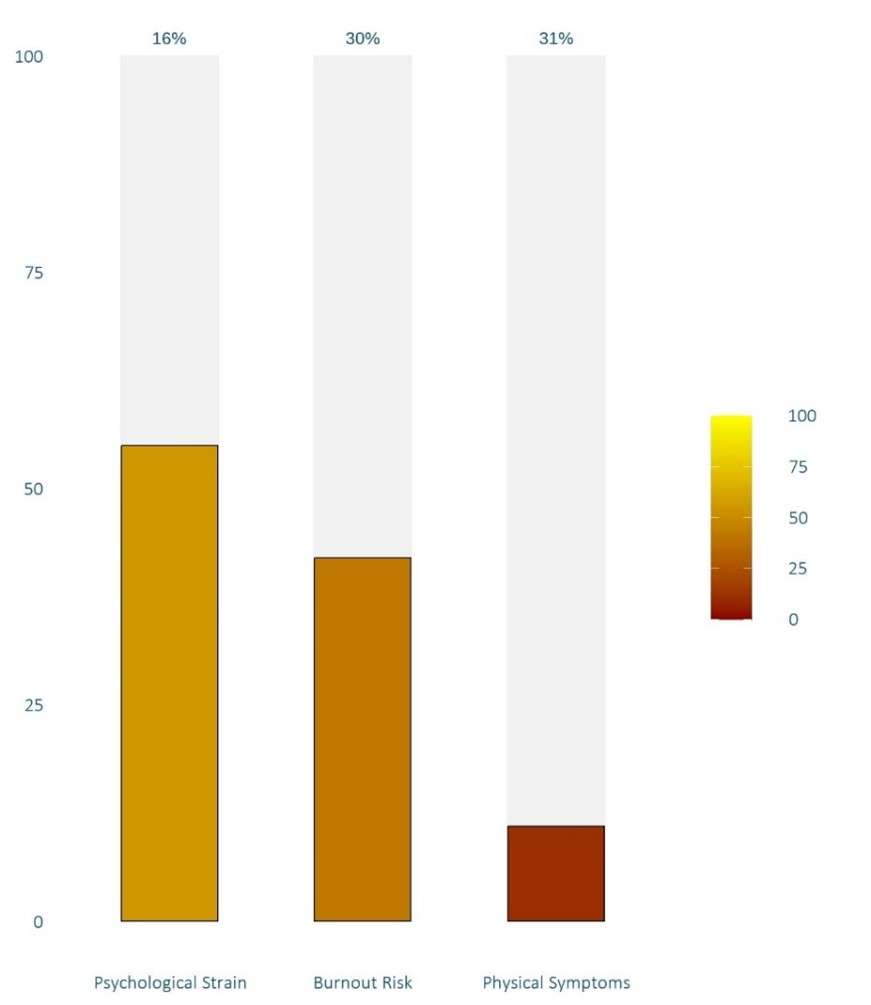
Connect with us
If you would like to learn more, please reach out and one of our Workplace Strategists will be in touch within 24 hours.
Empowering leaders to cultivate performance and psychosocial wellbeing
Performance conversations are a necessary activity for leaders that can be challenging yet have significantly positive impacts when undertaken effectively. Most workplaces have processes and procedures for managing performance and traditionally, these guidelines have been built using human resource and performance frameworks.
More recently, Australian Workplace Health and Safety Legislation provides workplaces greater clarity for integrating psychosocial hazard management in workplace activities. It has also amplified the need for leaders to consider the mental health of their people. There have been recent cases from the Fair Work Commission and Workplace Health and Safety Regulator prosecutions, which indicate the potential legal implications and liability that can arise for employers from performance and management processes.
In the modern context of leadership, managers and supervisors are therefore experiencing increased complexity in performance conversations. They must now apply IR knowledge, HR frameworks and a clear understanding of psychosocial factors, to navigate an already difficult interaction.
Gaining clarity on what you are managing
Leaders are often confused by the differences between mental illness, mental health, and personal stressors.
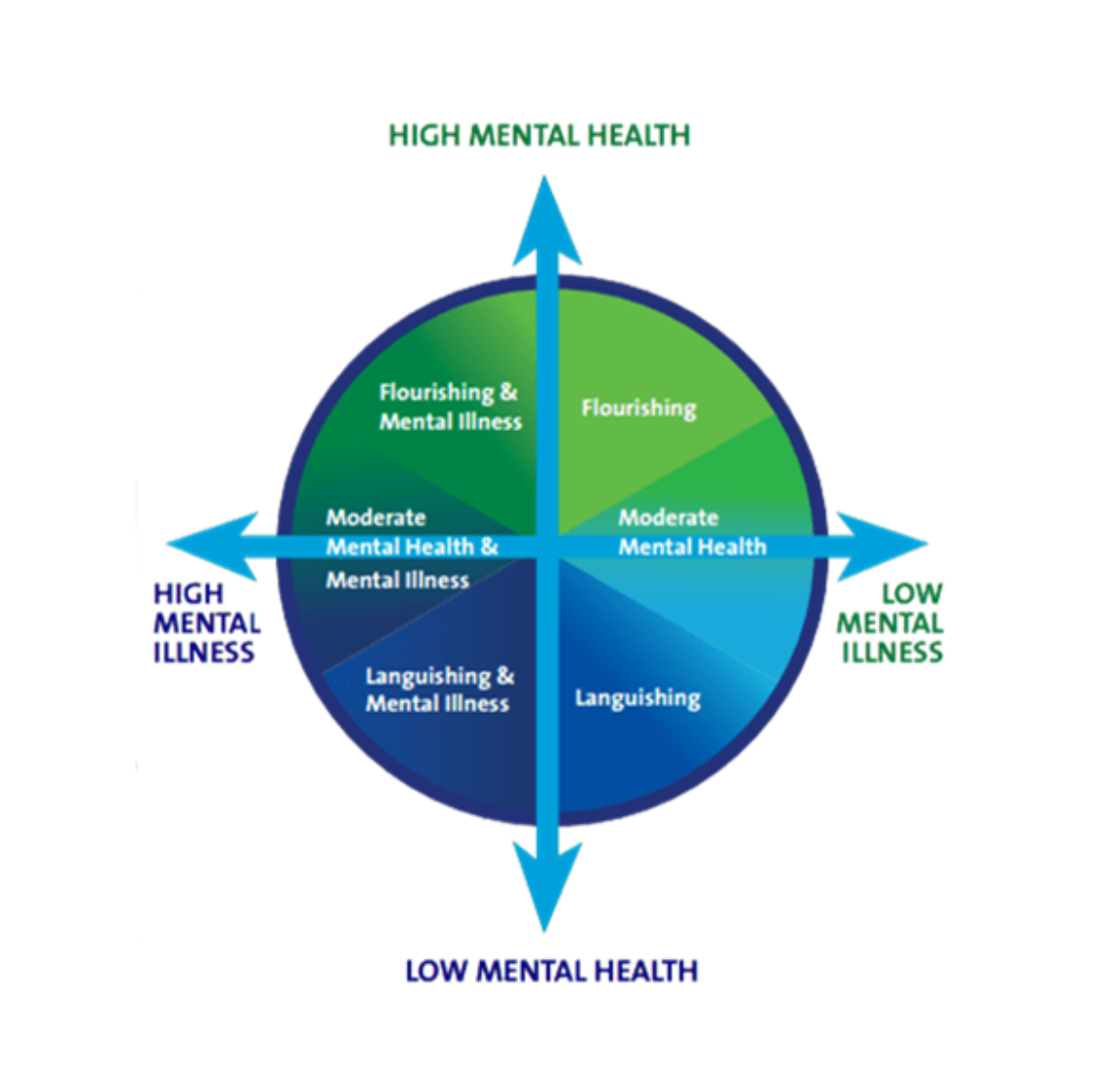
Keyes Dual Continuum Model of Mental Health
The Keyes Dual Continuum Model of Mental Health provides a helpful framework to remind us that mental illness and mental health are linked but separate concepts.
For example, a staff member with a previously disclosed mental illness may have proactive and reactive coping strategies in place resulting in high mental health. Conversely, a staff member with no mental illness, may be experiencing low mental health due to a current and temporary personal stressor.
Whilst not responsible for managing personal stressors that are not work related, The Code states that when aware of an existing concern, an organisation should ensure that psychosocial hazards do not create further harm, so far as is reasonably practicable (pg. 7).
The implications on your performance management processes:
- Proactively consider psychological health and safety in your performance management processes; be aware of the hazards, consider how the hazards may be brought about by the process, consider what controls need to be put in place and whether anything needs escalating.
- Support staff in having safe conversations with their leader, factoring in wellbeing and mental health.
- Seek professional guidance and/or leadership training on what to say and do when mental health is raised.
Common business risks arising from this increased complexity:
- Leaders avoiding performance conversations resulting in issues escalating and spilling over to team members.
- Leaders “delegating” performance conversations upwards and/or to HR for action.
- Staff complaining of unfair, stressful, or harsh, performance expectations.
- Engagement surveys reporting unfair performance management.
Mapien are increasingly working with clients proactively, and reactively, to improve the effectiveness of performance management processes and discussions when mental health or personal stressors are present.
In May, we’re launching our Performance Conversations Workshop.
Are mental health or personal issues impacting your Performance Conversations? Learn how to approach performance conversations when mental health or personal issues show up at our new one-day workshop.

Register today for our Brisbane Performance Conversations workshop!
| Date: | Wednesday 8 May 2024 |
| Time: | 9:00am – 4:00pm |
| Location: | Mapien | Level 10, 340 Adelaide Street, Brisbane |
| Cost: | $895 +GST (or $795 +GST Early Bird before 30 April) |
| + $195 +GST to join Leadership Café |

If you would prefer an another date to 8th May in Brisbane or in another location, we will be delivering this program over the coming months again in Brisbane, Sydney, Melbourne, and Perth.
If you’re interested, or know someone who is, please visit our events page and join our waitlist here!
Connect with us
If you would like to learn more, please reach out and one of our Workplace Strategists will be in touch within 24 hours.
In the decision of Skei Batton v The Environment Centre NT Inc [2024] FWC 597 dated 6 March 2024, the Fair Work Commission (‘FWC’) determined that an employee’s dismissal was unfair due to a denial of procedural fairness on the basis that the same person conducted the disciplinary investigation and made the decision to terminate.
The facts
On 26 July 2022, the employee commenced employment as a Finance and Office Manager with the employer, which is a small not-for-profit organisation.
As result of the employee’s alleged behaviour towards the Treasurer and Executive Director during a meeting on 24 July 2023, being absent from work without leave and repeated failure to carry out the Executive Director’s lawful and reasonable directions (‘alleged unprofessional behaviours’), the Executive Director undertook a disciplinary investigation. This included the Executive Director issuing the employee with a ‘Notice of warning and investigation’ letter dated 28 July 2023 that required the employee to respond to allegations concerning the alleged unprofessional behaviours. The employee was allowed an adequate opportunity to respond to the allegations.
On 17 August 2023, the Executive Director sent an email to the employee attaching the investigation findings that substantiated the alleged inappropriate behaviours thereby supporting a decision to terminate with 2 weeks pay in lieu of notice. The email also offered the employee an opportunity to resign and attached a proposed ‘Settlement Agreement and Deed of Release’.
There was no agreement to resolve the proposed termination thereby resulting in the Executive Director issuing the employee with a termination letter dated 28 August 2023. The termination letter advised the employee that the alleged unprofessional behaviours were substantiated, she had engaged in “misconduct of a very serious nature” and would be paid 2 weeks pay in lieu of notice.
The decision
On 7 September 2023, the employee lodged an application for unfair dismissal and the employer raised a jurisdictional objection on the basis that it was a small business employer that had complied with the Small Business Fair Dismissal Code.
The FWC determined that the employer had complied with the fundamental requirements of section 387 of the Fair Work Act 2009 (Cth) such as there being a valid reason for dismissal, notification of the reason for dismissal, an opportunity to respond and no refusal of a support person. In relation to whether the employee had been warned about her unsatisfactory performance prior to dismissal, the FWC noted that the employee was not confident performing her assigned audit and budget tasks due to not being a qualified Accountant, she should have been provided with more support and that the situation became too overwhelming.
The FWC noted that the employer was a small employer that did not employ any HR specialists. However, in relation to the consideration of any other matters, the FWC noted that the employee was entitled to a fair disciplinary process and that the Executive Director was both a witness and complainant to the behaviour of the employee. The FWC was critical of the Executive Director for having conducted the investigation and making the decision to terminate the employee’s employment.
The FWC was of the opinion that the investigation should have been conducted by an independent third party or a member of the Board with the Board then tasked with making a decision about the employee’s employment (presumably excluding the Board member that would undertake the investigation). The FWC referred to the Executive Director assuming the role of “judge, jury and executioner” and that this was inappropriate and thereby denied the employee procedural fairness. The employer’s objection on the grounds of compliance with the Small Business Fair Dismissal Code did not override its obligation in relation to procedural fairness. The FWC also took into account that the employee was a single mother and a survivor of domestic violence.
The FWC determined that the lack of procedural fairness necessitated a finding that the employee’s dismissal was harsh and ordered 12 weeks compensation (less tax) plus superannuation.
Key takeaways
A workplace investigation that does not adhere to the rules of procedural fairness will not only negate the investigation findings but also any decision made on the basis of that investigation.
A fundamental rule of procedural fairness is the rule against bias whereby the investigator must be impartial and not be subject to actual or apprehended bias.
Actual bias occurs where there is evidence that the investigator acted with prejudice or had an inclination for or against an individual involved in the investigation. This requires cogent evidence that the investigator was in fact bias.
Apprehended bias does not require direct evidence but an objective assessment of the investigator’s state of mind. It is sufficient to prove that the circumstances are such that the investigator could have been affected by bias.

The High Court in Ebner v Official Trustee in Bankruptcy (2000) 205 CLR 337 at paragraph 33 set out the test as follows:
“…whether a fair-minded lay observer might reasonably apprehend that the judge might not bring an impartial mind to the resolution of the question the judge was required to decide.”
In this FWC decision, the Executive Director was clearly the subject of apprehended bias having been a witness and more importantly a complainant to the behaviour of the employee. Therefore, it was a breach of procedural fairness for the Executive Director to conduct the investigation. Similar considerations apply with respect to making a decision about termination of employment as noted by the FWC. This is particularly the case given the ability to utilise Board members.
Connect with us
Mapien is a market leader in managing difficult employee issues, including conducting workplace investigations. If you would like to know more about procedural fairness when conducting workplace investigations, please contact us and a Mapien Workplace Strategist will be in touch within 24 hours.
This is blog #8 in our series on coaching models. Sign up to our mailing list to make sure you don’t miss out on our future content.
You wouldn’t throw a coin in a fountain and wish you’d magically meet your quarterly KPIs, would you? But we’ve all heard the saying… a goal without a plan is just a wish!
The fact is, in order to make your goals happen, you need to set clear intentions and create a plan you can actually follow through on. Many leaders use the SMART framework to develop their own goals in the workplace, or to coach and mentor teams through goal setting.
We’re huge fans of this method, too — but it’s worth taking a look at its origins, the research behind it, and how you can improve on the SMART method with new criteria to make it even more practical for setting and achieving goals.
Origins of the Smart Goals
SMART goals have been around since 1981 when consultant and management expert George Doran introduced the concept in an article, “There’s a S.M.A.R.T. way to write management goals and objectives”.
The main idea behind SMART is to outline five key criteria for writing and structuring goals in a more practical way: Specific, Measurable, Achievable, Relevant, and Timely.
More than four decades later, SMART goal setting remains a hugely popular method used in a variety of fields, including business, management, education, and professional development.
SMART Goals: What the Research Says

The SMART goal setting technique has been studied by a number of researchers over the years.
For example, one study found that this approach to setting goals at work led to more flow, lower stress, higher engagement, and better performance. Meanwhile, another study found that students that were required to use SMART goals early in the semester improved their learning outcomes.
Other researchers have looked at the specific criteria behind goal setting. For instance:
- This research paper examined how goals influence performance, finding that a specific goal caused individuals to plan and organise more than a general goal.
- This research showed that quantification (i.e. turning goals into measurable data) can promote goal pursuit motivation, and being able to track progress on a goal can increase self-empowerment.
- Another study looked at students who were learning a language and found that setting achievable goals made both teaching and learning more effective, as this kept learners motivated for task performance.
- In this study, motivation to continue pursuing a goal is also impacted by the amount of time remaining, where a goal is time-bound.
- Relevance is another important factor for goal-setting success, with studies finding that task performance is a function of goal level, self-focus, and perceived goal importance.
Overall, research confirms that the combination of SMART criteria can help people realise the level of self-efficacy and motivation needed to achieve their desired outcomes. That said, newer research also suggests that it may be possible to expand on the original model and improve it…
Social Boosting: The Missing SMART Criteria

Recently, we’ve seen an increase in performance research that emphasises the importance of social boosting. This comes from building in various points of accountability throughout the duration of the goal.
The following examples of research support the benefits of accountability in goal setting:
- This paper found that accountability during the goal pursuit process was positively related to performance improvement in a complex decision-making task.
- This article argues that social and personal methods of pursuing goals can work together to improve goal pursuit, with individuals frequently achieving goals by relying on others.
- This research found that accountability (in the form of weekly progress reports) had a positive effect, with participants accomplishing significantly more than others.
- This literature review discusses findings that employees with greater personal accountability perform at a higher level than those that do not.
- The results of this research indicated that the social and motivational factors of participation in goal setting increased performance, goal acceptance, group commitment, incidental learning, and satisfaction.
Based on these findings, there appears to be growing value in incorporating a second “S” to represent the Social element of effective goal setting. As such, we propose updating the model to SMART(S) to cover all six criteria points.
How Leaders, Coaches, and Mentors Can Apply SMART(S)
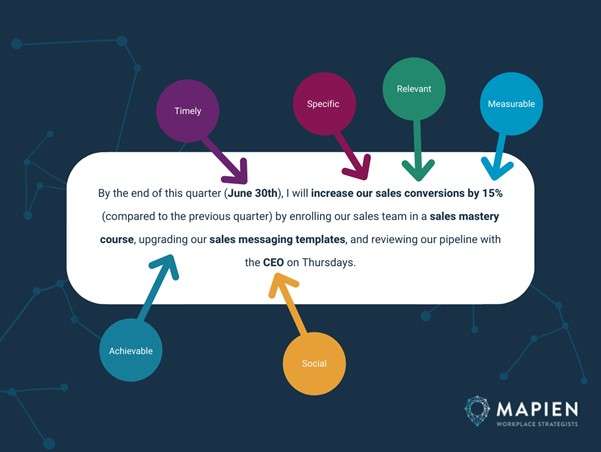
As a leader, you need to be confident enough with the SMART(S) goal setting framework to develop your own goals, and to guide others through the process. Although SMART(S) goals aren’t necessarily difficult to develop, it’s worth becoming more familiar with the model so that you can provide feedback and prompt others if they get stuck.
We’ve broken down each of the criteria below, along with examples and prompts to help define and refine your goals.
Specific – Simple, Succinct & Focused
Example: Increase sales conversions
Consider your broader goal and what you want to achieve — for the above example, our broader goal is to increase sales. Now start to refine this goal into something more specific. Useful prompts for getting specific include:
- What exactly do you want to accomplish?
- How do you see yourself achieving your broader goal?
- Who, if anyone, needs to be involved?
- What is the reason, purpose, or benefit behind accomplishing your objective?
Measurable – Track Your Progress
Example: Increase sales conversions by 15% (compared to the previous quarter)
Expand on your stated goal with detail on how you’ll track your progress or determine your success. Useful prompts to help make your goal measurable include:
- How will you know you’ve reached your goal?
- What will indicate you’ve made progress?
- How can you quantify your achievement?
- What data or feedback will help you track your progress or success?
Achievable – Skills, Will & Resources
Example: By enrolling our sales team in a sales mastery course, upgrading our sales messaging templates
Add more details to your goal, breaking it down into practical actions and steps that you can realistically accomplish. Some useful prompts for this criteria include:
- How will you upskill or build the necessary capabilities?
- What resources will you need?
- Is it realistic to take these steps within the time and budget you have available?
- Is the amount of required effort reasonable, considering what the goal may achieve?
Relevant – Important & Meaningful
Example: Sales conversions
Review your current work-in-progress through the lens of relevance. There’s no point in going any further unless your goal is important and meaningful to you, your work, and/or your team. Useful prompts for considering relevance include:
- Is it worthwhile?
- Is this the right time?
- Does this align with our other efforts?
Timely – Set Deadlines & Milestones
Example: By the end of this quarter (June 30th)
Incorporate timing into your goal to give yourself a deadline to achieve it by, or checkpoints for specific outcomes. Some prompts to help determine timing include:
- When will you achieve the objective?
- When do you expect to see some short-term outcomes?
- What timing is realistic but challenging?
- How might this timing impact your other projects?
Social – Involve others for Accountability
Example: Reviewing our pipeline with the CEO on Thursdays
Finally, incorporate a social element to help you be accountable to others, and increase the likelihood that you follow through on your commitment. Some prompts to help shape your social element include:
- Who else will be involved in the process?
- Who is best positioned to keep you accountable?
- When and how will they be involved?
Discover More Leadership & Coaching Resources
Enjoyed learning about SMART(S) goal setting and looking for more leadership and coaching resources? We’ll be back soon with more coaching models in this series, or you might be interested in checking out some of our previous models, such as the GROW Coaching Model, the Situational Leadership Model, the Stages of Change Model, and Understanding Stealth Expectations.
Or you’re welcome to drop us a line if you’d like help implementing a coaching and mentorship program in your workplace.
Non-compete clauses in employment contracts have long been a topic of debate, with proponents arguing they protect a company’s interests and detractors claiming they stifle employee mobility and innovation, as well as restrain the trade of employees; essentially depriving them of the opportunity to use their skills to earn a living.
Historically, non-compete clauses have been successfully used for high paying, corporate executive level roles, where employers needed to protect their business. At this level, employers were able to launch an argument built around protecting their intellectual property, business networks and their investment into the employee, which often resulted in individuals needing to take some time out of working (Gardening Leave), before commencing with a new employer.
One issue is that employers have been using these sort of clauses for lower-level positions in an attempt to retain workers and prevent them from moving to competitors. These have yielded limited success because they are generally found to be not fair, not enforceable and for roles at that level, are just not necessary.
The recently released Non-competes and Other Restraints: Understanding the Impacts on Jobs, Business, and Productivity Issues Paper (Issues paper (treasury.gov.au), sheds light on the complexities and consequences associated with these contentious clauses.
One of the key recommendations from the Issues Paper is for employers to carefully consider the necessity and scope of non-compete clauses in their contracts. It emphasises the importance of balancing the company’s interests with employee rights and the potential negative impacts on job growth and productivity. Employers are urged to tailor non-compete agreements to specific roles and industries to prevent overreach and unintended consequences.
Moreover, the Issues Paper highlights the importance of transparency and communication when implementing non-compete clauses. Employers must clearly explain the rationale behind the clauses and provide employees with a full understanding of their rights and responsibilities. Open dialogue and clear expectations can help mitigate potential conflicts and misunderstandings down the line.
Another key lesson for employers is the need to regularly review and update non-compete agreements to ensure they align with current laws and industry standards. As regulations regarding non-compete clauses continue to evolve, employers must stay informed and adapt their practices accordingly. Failing to do so could leave them vulnerable to legal challenges and reputational harm.

The Issues Paper serves as a valuable resource for employers grappling with the complexities of non-compete clauses in employment contracts and provides some items to consider further for those employers who are thinking of inserting such clauses. By following the key recommendations and lessons outlined in the paper, employers can navigate the challenges associated with non-competes while promoting fairness, innovation, and productivity in the workplace.
While it is important for employers to retain talent, a non-compete clause may not be the best approach for all levels within your business. Ultimately, employers may be better off seeking to understand why employees are looking to leave in the first place and how they may be able to address other cultural issues overall. Further to this, it might pay to part ways with the employee in an amicable way with the key message of, “give us a call if it’s not working out”.
This is an area of employment that is attracting a lot of attention so be sure to keep an eye on how it plays out. The carrot is often better than the stick, particularly if the stick can’t actually be used.
Connect with us
If you would like to know more, please contact us and one of our Workplace Strategists will be in touch within 24 hours.
The High Court has, in refusing to hear an appeal from a decision of the Full Court of the Federal Court, confirmed that an enterprise agreement with retrospective application may apply to employees who were not employed when the agreement commenced.
Agreement Context
In November 2020, the Fair Work Commission approved The Catholic Employing Authorities Single Enterprise Collective Agreement – Diocesan Schools of Queensland 2019–2023 and The Catholic Employing Authorities Single Enterprise Collective Agreement – Religious Institutes Schools of Queensland 2019–2023.
Both agreements stated that, “Where this Collective Enterprise Agreement specifies an earlier operative date in relation to a particular provision, then that provision shall operate from that date for all applicable employees employed at that earlier date”, and provided for salary increases effective from 1 July 2019 and 1 July 2020.
Proceedings before the Court
Two teachers, one who resigned on 6 December 2019 and the other who resigned on 31 December 2019, sought back pay from their former employers under the new agreements.
After both employers refused the claim, the teachers with the support of the Independent Education Union of Australia brought proceedings in the Federal Court.
The Full Court of the Federal Court found that:
- On the date of the commencement of the agreements, the whole of those agreements come into operation;
- The salary increase provisions of the agreements had retrospective effect from 1 July 2019 for applicable employees;
- The agreements did not exclude employees who were not employed at the time of approval from being applicable employees;
- The teachers were applicable employees covered by the agreements as at 1 July 2019 because they were employed at that time; and
- The teachers were consequently entitled to the applicable salary increase from 1 July 2019 until their respective resignation dates.
Consideration for Employers
The Full Court decision concerned the meaning of “applicable employee” within the context of the agreements, and it found that the term included employees who were employed as at 1 July 2019.
The decision does not create a general obligation upon employers to provide backpay to past employees where wage increases are backdated and the employees are not employed when the agreement commences operation.
The retrospective application of each agreement must be considered on its own wording, but the decision highlights that careful consideration needs to be given to the scope and application clauses of any proposed enterprise agreement and the drafting of such clauses.

Connect with us…
If you have any concerns regarding the application of your enterprise agreement, we encourage you to speak with your Mapien consultant, or please contact us and one of our Workplace Strategists will be in touch within 24 hours.
Determining who qualifies as a “shiftworker” and is entitled to additional annual leave under the National Employment Standards (NES) can be a complex task, and the consequences of getting it wrong can be costly.
Many awards and agreements define a shiftworker, for the purposes of the NES annual leave entitlement, to mean “a 7-day shiftworker who is regularly rostered to work on Sundays and public holidays”.
In the recent decision of Bega Dairy and Drinks Pty Ltd formerly known as National Foods (Dairy Foods) Limited v United Workers’ Union [2024] FWC 171, the Fair Work Commission provided further clarification of the definition of a shiftworker.
The Commission firstly held that in order to meet the definition of a shiftworker, an employee needed to work both a 7-day roster and be regularly rostered to work on Sundays and public holidays.
The Commission also held that the employer’s shift operations did not need to be continuous (that is, 24/7), however the employee needed to work on at least part of each of the 7 days of the week over a relevant roster period.
Crucially, the Commission found that a shiftworker who worked on a fixed roster (for example, Monday to Friday) did not meet these requirements and was not a 7-day shiftworker.
The parties had recognised the principle, established in O’Neill v Roy Hill Holdings Pty Ltd [2015] FWC 2461, that the phrase “… who is regularly rostered to work on Sundays and public holidays” means an employee who has worked at least 34 Sundays and 6 public holidays in a year and the Commission proceeded on that basis.
An additional week’s annual leave?
Consequentially, only shiftworkers who:
- performed work on each of 7 days of the week under a rotating roster; and
- worked at least 34 Sundays and 6 public holidays,
were entitled to an additional week’s annual leave.
The Decision provides useful guidance on how the term “shiftworker” will be interpreted in a number of modern awards and agreements. It should also be noted that whilst the Roy Hill standard has been accepted in relation to many modern awards and agreements, its application is not universal.

Next Steps...
Employers should carefully review the shiftworker definition applicable to their industry and industrial instruments to ensure that they are correctly applying the NES annual leave entitlement.
If you would like to know more, please contact us and one of our Workplace Strategists will be in touch within 24 hours.
This is blog #7 in our series on coaching models. Sign up to our mailing list to make sure you don’t miss out on our future content.
Ever found yourself getting caught up in feelings of disappointment and resentment towards others in your workplace? Or feel like the people within your circle continually miss the mark?
Maybe it’s a skills and development gap, but a more likely explanation is that you’ve been operating in stealth mode without realising it. And that the real missing piece of the puzzle isn’t scheduling a bunch of team training, but developing a shared understanding.
It’s time you were introduced to the concept of stealth expectations…
What are Stealth Expectations?
A stealth expectation is something that you (or the people around you) expect from others, but are not consciously aware of. It’s an imagined reality or outcome – something that you anticipate, predict, believe, or hope will happen.
People tend to develop stealth expectations of themselves and of others, based on their previous experiences, their knowledge, or their own personal wants and needs.
Why Stealth Expectations Matter
“Stealth expectations and disappointment have been the sources of some of our most difficult arguments and hurt feelings.”
– Brene Brown
Stealth expectations influence your thoughts, feelings, and behaviours — and these will impact your interactions with others, your actions, and your environment. The tricky part is that you may not realise where these thoughts, feelings, and behaviours are coming from unless you pay very close attention.
On top of this, not meeting stealth expectations can lead to some negative side effects:
- When you fall short of your own stealth expectations – You may develop feelings of shame, unworthiness, and negativity towards yourself
- When the people around you don’t meet your stealth expectations – You’ll likely feel disappointed, resentful, frustrated, and even bitter
- When you don’t meet someone else’s expectation of you (that you were not aware of) – They may feel and act upon their feelings of frustration and disappointment towards you
Steal expectations are a quick way to ruin your own day, entirely by accident. But the good news is that with a little self-reflection, you can take control of them and get back on course!
Why Leaders Must Unpack Stealth Expectations

It’s normal to have expectations — it’s part of being a human! In fact, studies have found that social expectations are rooted in the natural human drive for reciprocity. And it’s normal for different people to have different expectations, because we all have unique backgrounds, perspectives, beliefs, and experiences.
But stealth expectations can very quickly become an issue for people, and especially for leaders.
They can lead to:
- Lower motivation, productivity, and performance
- Negative workplace interactions
- Disconnected teams
- Difficulty agreeing on what makes something a success or failure
- Difficulty identifying expected outcomes or a way forward in projects
To sum it up, stealth expectations create barriers to developing the kind of shared understanding that enables effective teams. And as a leader, it’s important to develop a conscious awareness of your own expectations (and the expectations of those you work with) so that you can manage them and lead more effectively.
4 Steps Towards Shared Understanding
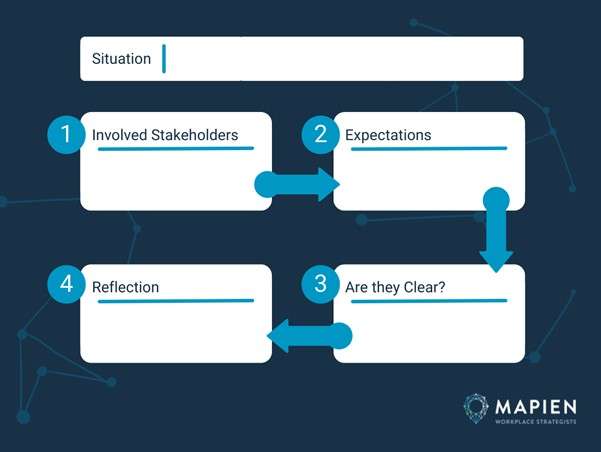
The key to managing stealth expectations is first becoming aware of them — and then making other people aware of them. Here’s a process you can follow to discover and break down your own expectations:
Step 1: Who’s Involved?
First, consider a situation or task in which you’re having difficulty and would like to improve the way you work with others. Note down any other people or stakeholders involved in the task or situation.
Here are a few example situations that might come up as a leader:
Situation 1: Monday morning meetings — difficulty with attendance and participation from team members.
Involved Stakeholders:
- Marketing Director
- Sales Director
- Chief Financial Officer
- Executive Assistant
2: Workplace inclusivity — difficulty with reaching target numbers and feedback survey suggests this could be better.
Involved Stakeholders:
- Human Resources Team
- Hiring Managers
- All other staff in decision-making positions
3: Meeting deadlines — difficulty with team meeting deadlines to deliver the new software product.
Involved Stakeholders:
- Project Manager
- Product Owner
- Developers
- Designers & UX
- Quality Assurance
- Legal
- Marketing
Step 2: What Are the Expectations?
Now it’s time to identify what your expectations are in the situation you noted. You may have one expectation that applies to all the involved stakeholders, or you may expect different things from different people. To help identify all your expectations, imagine your stakeholders showed up in the situation and did nothing — then note down everything they should be doing instead.
For example, let’s break down what your expectations might be for the example in step 1 where attendees are struggling to attend and participate in Monday morning meetings.
| Involved Stakeholders | Expectations |
|
Marketing Director |
|
|
Sales Director |
|
|
Chief Financial Officer |
|
|
Executive Assistant |
|
Step 3: Is It a Stealth Expectation?
Reflect on the expectations you recorded in step 2.
Ask yourself…
- Was this expectation developed through a shared understanding (rather than my own personal and private interpretation of what should happen)?
- Was this expectation clearly communicated to others?
- Have others confirmed they correctly understood my expectations?
- Have I confirmed with others that their understanding is correct?
If you answered no to any of these questions, it’s likely that you’re dealing with a stealth expectation.
To continue our example, we may discover that it was never communicated that three of the four stakeholders should arrive before the meeting is scheduled to begin. We may also realise that although both the Marketing Director and Sales Director sometimes bring reporting materials, this expectation was never communicated. Finally, we may discover that although the Executive Assistant was told to set up the room, they were never told that this should include water on the table, a clean whiteboard, and fresh notebooks.
Step 4: Reflections
Now that you know what your stealth expectations are, it’s time to reflect on them and start to make changes. Ask yourself how you could more clearly communicate any stealth expectations to others. And be sure to ask others to rephrase the expectations you’ve communicated in their own words to confirm there is a shared understanding.
Building on our Monday morning meeting example, the reflection process might lead you to make several changes to clarify your expectations. For instance, you might produce a more detailed meeting agenda template that clearly outlines what time to show up and what each person needs to prepare for the meeting. And you could provide written and verbal instructions so that the Executive Assistant knows exactly how to prepare the room for a meeting.
Optional Extras
Although the stealth expectations process was not designed to tell you whether your expectations are reasonable or not, through self-reflection, you may realise that some expectations are unrealistic within the situation. In some cases, you may choose to let go of or adjust an expectation before communicating it to others.
Finally, you may like to take your reflection one step further by considering what others may also expect of you in the given situation or task. Have you clarified your understanding of their expectations? And have others confirmed that you correctly understood what was expected?
Explore More Practical Tools for Leaders
Of course, the stealth expectations framework is only one of many coaching models you may like to add to your toolkit as a leader. We’ll continue this series with more coaching and leadership models like this one, but in the meantime, you can check out our previous posts covering:
- Using the Situational Leadership Model to Lead With Flexibility
- Using The Choice Point Method to Understand and Refine Behaviours
- Applying the GROW Coaching Model to Move Through Challenges
And if you’d like tailored support with leadership coaching, we’d love to help. Simply reach out to our team today and we can start the conversation.
The High Court of Australia has delivered a decisive verdict, fundamentally altering the landscape for employers. The ruling, stemming from the case of Construction, Forestry, Maritime, Mining and Energy Union v OS MCAP Pty Ltd [2023] FCAFC 51, solidifies that employers must formally request employees to work on public holidays, setting a precedent with significant consequences for businesses.
Formal request to work on public holidays
Last year, the Federal Court of Australia clarified that employers must formally request employees to work on public holidays. This Decision arose after BHP’s in-house labour hire provider OS MCAP Pty Ltd was accused of contravening the National Employment Standards (NES) by requiring employees to work on Christmas Day and Boxing Day in 2019.
The Full Court’s decision established that for an employee to be obliged to work on a public holiday the employer must make a reasonable request and that any refusal by the employee must be unreasonable. Employers are now obligated to review their practices, ensuring that employees are aware of their right to refuse public holiday shifts. This includes incorporating penalties for working on public holidays into the request, potentially increasing the likelihood of employee acceptance.
Following the Full Court ruling, BHP sought special leave from the High Court to challenge the decision. Despite attempts by BHP to challenge the Full Court’s decision, the High Court justices, Michelle Gordon and Robert Beech-Jones, rejected the special leave request. Consequently, the High Court also reaffirmed the Full Court’s interpretation, stating that a “request” under s114(2) of the Fair Work Act connotes its ordinary meaning, giving employees the choice to agree or refuse to work on a public holiday. The court emphasized the need for discussion and negotiation, allowing employers to require employees to work on a public holiday only if the request is reasonable and the employee’s refusal is unreasonable.
A transparent approach
Employers must now be diligent in formally requesting employees to work on these days, ensuring transparency and openness in the process. Failure to comply with this requirement may lead to legal consequences, as highlighted by the CFMMEU’s claim against BHP for allegedly flawed leave deductions, potentially resulting in over $400 million in backpay to employees.
As Easter, Anzac Day and Labour Day public holidays are approaching, employers are also urged to undertake a comprehensive review of their employment practices, specifically scrutinizing employment contracts and policies to ensure compliance with legislative requirements. Businesses should consider promptly implementing new policies governing the process of requesting and refusing work on public holidays.

Connect with us
If you would like to know more, please contact us and one of our Workplace Strategists will be in touch within 24 hours.
Welcome to our blog series on common job hazards. In this article, we’re diving into one prevalent psychosocial hazard that impacts us all – conflict or poor workplace relationships and interactions.
We will shed light on this workplace challenge, showing you where to start on the symptoms, and explore how you can foster healthier workplace dynamics through effective intervention and ongoing support.
Conflict or poor workplace relationships and interactions
Definition: Poor workplace relationships or interpersonal conflict can occur between managers, supervisors, co-workers or others.
Example: Rude comments between managers, supervisors, co-workers and others; unresolved conflict regarding work tasks, processes, customers, or other interpersonal issues.
Understanding Hazard Complexity
Workplace hazards can often interact in unexpected ways, making them a puzzle to solve. Conflict or poor relationships among colleagues can manifest in various forms, from subtle tensions to more overt issues.
But how do you even begin to address these complexities?
We’ll show you where to start and provide insights into recognising workplace symptoms.

The Power of Early Proactive Actions
Early intervention plays a pivotal role. We all know that prevention is better than finding a cure, and that’s especially true when it comes to workplace dynamics. Addressing incivility and informal complaints in their early stages can prevent them from turning into more serious problems like bullying, grievances, or formal complaints.
Incivility is often a pre-curser to workplace bullying and is important to address early, to reduce the likelihood of interpersonal tensions escalating.
Workplace incivility can be defined as, “behaviour that is low-intensity, unclearly harmful, violating mutual respect norms at work, marked by rudeness, disrespect, and disregard for others. It includes ignoring, excluding, demeaning language, interruptions, not listening, and unsociable attitudes. Its subtle nature can foster a toxic environment, reducing job satisfaction, raising stress, and lowering productivity (Andersson & Pearson, 1999)”.
Examples involve non verbals such as eye rolling, not greeting others, unkind comments, and ignoring people.
1. Leadership Support
Supportive leadership is key to enhancing workplace relationships. Leaders who adopt a transformational style, which emphasises inspiring and motivating their teams, play a crucial role in improving relationships and performance. By going beyond mere procedural adherence and offering genuine support and understanding, these leaders can effectively address and mitigate various workplace challenges, preventing conflicts and fostering a healthier work environment. Supportive leaders also will intervene early and authentically when problems in teams occur to reduce the risk of interpersonal issues.
Transformational Leadership: Leaders who inspire and motivate their teams often see improved relationships and performance. This is one of many characteristics of leadership, a group process, that can achieve increased support for their team members and helps to reduce the impact of stressors experienced in their workplace (also knowns as a “protective factor”).
2. Promotion of Psychological Safety in Teams and across Organisations
Psychological safety is a term researched extensively by Professor Amy Edmonston.
It is defined as “the belief in the safety of taking interpersonal risks in team settings. It exists when members can freely express ideas, concerns, admit errors, and suggest innovations without fear of ridicule or punishment. It is a key aspect in promoting team innovation, learning, and performance. Teams with high psychological safety engage more in productive collaboration, learn from failures, and achieve shared objectives” (Edmondson, 1999; 2018).
This involves creating an environment where employees feel included, can learn, contribute, and challenge the status quo without fear of repercussions. This is achieved through:
- Inclusion Safety
- Learner Safety
- Contributor Safety
- Challenger Safety

4 Stages of Psychological Safety
1. Inclusion Safety: Embracing every individual by valuing and accepting them for who they are.
For example, a team leader makes a conscious effort to learn about cultural differences and ensures all team meetings are scheduled at times that are inclusive for team members across different time zones. Additionally, the leader regularly checks in with each team member to understand their unique perspectives and contributions, emphasising that each voice is critical to the team’s success.
2. Learner Safety: Questions are comfortably asked, and individuals feel safe to experiment by trying new things.
For example, a company implements a continuous improvement policy for mistakes and instead of blaming, encourages a debriefing session where teams can discuss what went wrong, what was learned, and how to improve in the future. This practice ensures that individuals feel comfortable admitting mistakes and learning from them without fear of punishment.
3. Collaborator Safety: Environment that fosters constructive debate and provides for a constant and perpetual state of open dialogue.
For example, during project meetings, a facilitator ensures that everyone has a chance to speak and present their ideas. The team has established ground rules for respectful communication and constructive feedback, ensuring that debates are focused on ideas and solutions rather than personal criticisms.
4. Challenger Safety: Feeling safety to challenge the status quo and to do so with immunity from repercussions or reprisal.
For example, a team encourages innovation, thinking critically around new ideas and solutions. Open review and discussion would enable employees who ideas are implemented with recognition and reward. Also fostering an innovative environment will encourage constructive criticism about how things can be improved without fear of reprisal.
Clark, T. R. (2020). The 4 stages of psychological safety: Defining the path to inclusion and innovation. Berrett-Koehler Publishers.
3. Psychosocial Hazard Intervention: Employee Participation/Consultation
Enter Psychosocial Hazard intervention – a proactive approach to managing workplace health and safety under the Workplace Health and Safety Act. Through employee consultation and the application of compliance and the guidelines for managing psychosocial hazards (the Code), we aim to create a supportive and compliant work environment.
Encouraging open dialogue and active participation from employees ensures a more comprehensive understanding and management of these issues by finding opportunities to explore workplace systems and processes that may be adjusted to reduce the impact of workplace conflict.
For example, in hybrid teams, there may be a particular level, role, or team member within a team who systematically receives less contact or interaction with their team members or supervisor (e.g. part-time team member who doesn’t work on the days the team meets to explore the month ahead). Systematically being isolated from the team (which is a hazard too) can reduce the effectiveness of communication, increasing the likelihood of conflict, and reduces the opportunity to recognise, and resolve, conflict. Effective consultation can identify such an issue and team members can inform an alternative meeting rhythm and/or communication rhythm that becomes systematised and purpose-built to enable miscommunication to be proactively managed.

Key Takeaways
- Workplace hazards, like conflicts and poor relationships, are complex and need a thoughtful approach
- Early intervention can prevent minor issues from becoming major workplace problems
- Supportive leadership can transform workplace dynamics positively, promoting psychological safety
- Psychosocial Hazard intervention through Employee Participation/Consultation offers a proactive solution for workplace health and safety
Your Path to Healthier Workplace Relationships
In summary, conflict and poor workplace relationships are common job hazards that can have a profound impact on your organisation. Addressing these hazards requires more than just recognition; proactive action is needed.
Consider checking if your investment into Leadership Development programs includes evidence-based approaches that enable leaders, and their teams, to strengthen psychological safety and using purpose-built tools like a Psychosocial Hazard Current State Assessment or a Psychosocial Hazard Survey to identify the extent to which conflict may be negative impacting your employees, and how to progress.
Connect with us...
Contact us to explore how we can help transform your workplace into a safe and thriving environment!
References
Andersson, L. M., & Pearson, C. M. (1999). Tit for Tat? The Spiraling Effect of Incivility in the Workplace. The Academy of Management Review, 24(3), 452-471.
Clark, T. R. (2020). The 4 stages of psychological safety: Defining the path to inclusion and innovation. Berrett-Koehler Publishers.
Edmondson, A. (1999). Psychological Safety and Learning Behavior in Work Teams. Administrative Science Quarterly, 44(2), 350-383.
Edmondson, A. (2018). The Fearless Organization: Creating Psychological Safety in the Workplace for Learning, Innovation, and Growth.

